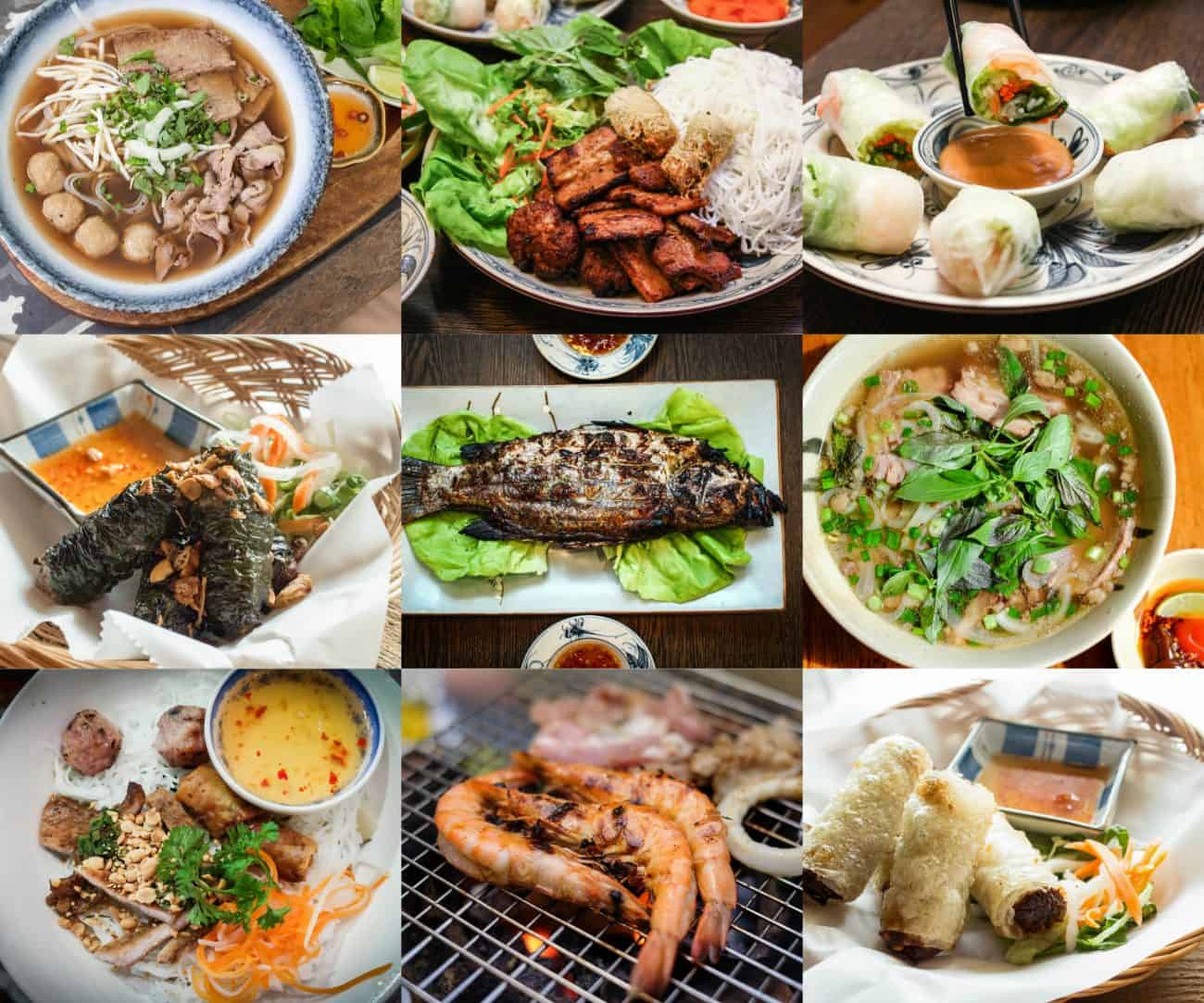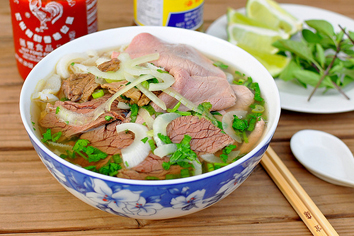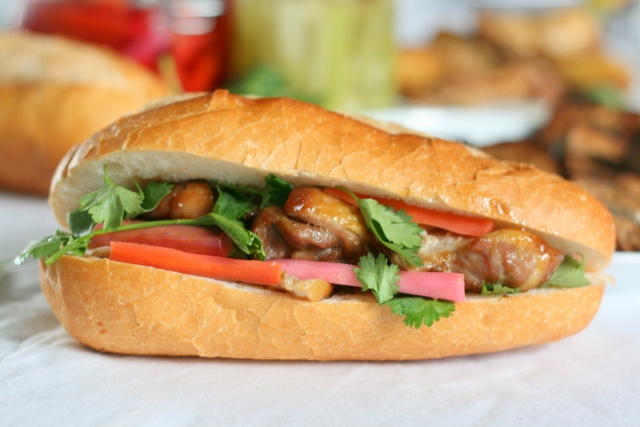“Internationally speaking, Thai food may be the most heralded of all the Southeast Asian cuisines, but true connoisseurs would go for Vietnamese every time…. Light, subtle in flavour and astonishing in their variety, Vietnamese dishes are boiled or steamed rather than stir-fried, and a huge emphasis is placed on herbs and seasoning – no great surprise in this land of diverse climates.” ROUGE GUIDE started its guide with those words to describe Vietnamese food.
VIETNAM FOOD AND CUISINE OVERVIEW
Vietnamese cuisine and street food are complimented several times by famous chefs and cuisine professionals. Located right next to a giant China with very strongly influent culture, many make a big mistake that Vietnam taste is similar to China. In fact, it is very much different in ingredients and taste that all are blended in astonishing recipes and then create divine and healthy gastronomy.

The most typical feature of Vietnam food is the fresh vegetable. Vegetable of all types are included in every dishes, sometimes they are main ingredients, and sometimes they are to create supporting taste. Spicy veggies and herbs are extremely popular. They can make a dish change their taste completely with different usage.
Most Vietnamese dishes are mostly well cooked. There is some kind of “sashimi” or medium rare cooked beef or port but they are not typical. Vietnamese distinctly loves boiled or steamed vegetable, meat, and fish. That is the best way to keep the fresh taste as well as the nutrients included inside the ingredients.
Some useful notices for visitors when enjoying a meal with Vietnamese:
- Vietnamese uses chopsticks to control the food during meals.
- Vietnamese shares dishes together. We put a sufficient amount of the dish into a big dish or bowl. Each person at the table uses their chopstick to take their share from this bowl.
- To show the hospitality, the host often takes food to the guests’ bowl for the first round and ask the guests make themselves at home to enjoy the meal.
- Many Vietnamese people use a toothpick after eating to clean our teeth.
- Man often drinks beer or local wine during their meals. Women and children do not.
- It is an etiquette to wait for the elder to sit and eat first.
- It is not compulsory to bring a gift or wine when you are invited to someone’s house to enjoy a meal. However, some fresh fruits or desserts are always welcome and highly appreciated.
Suggested Vietnam food tours: Vietnam Gastronomy Delights, Vietnam Food Adventure, Vietnam Cuisine Touch
Enjoying meals at restaurants
There are many in main cities with various in prices and standards. That is easy to find both Western and Vietnamese restaurants. With a sharp increase in Japanese and Korean tourist markets, these restaurants are becoming popular too, the prices are often higher than Vietnamese ones.

Note: when you are touring in Vietnam, you will be served mostly in a local restaurant.
Enjoying Vietnamese street food
Leaving in a tropical country, Vietnamese like noodle very much because noodle is soft and often served together with different types of soup. So it is very enjoyable on hot days while in cold weather, the only thing to do is to boil up the soup; you immediately have a hot, steaming dish to indulge your stomach. Noodles can easily get along very well with many added ingredients regardless of the fact that they are pork, beef, chickens, crab, shrimp, or nails etc. That is the reason why Vietnamese has dozen noodle types and hundred ways to cook dishes related to noodle.
The most famous ones must be “Pho” severed with beef or chicken, “bun cha” – noodle with grilled pork served with sweet and sour sauce and “hu tiu nam vang” – a specialty in South Vietnam includes noodle with shrimp, eggs, some slides of liver and grind pork.

The newly rising star of Vietnam cuisine recently is “Banh My” – Vietnamese styled bread. This is not a traditional dish of Vietnam as we are a country of rice, not wheat. However, when “Banh my” joined our cuisine, Vietnamese adjust it – less butter, cheese, meat then add more home-made pate, sauce, and herbs. We have created the so-called Vietnamese “Banh My” that is applauded all over the world as one of the most delicious bread ever.

YOUR POCKET LIST OF VIETNAMESE STREET FOOD:
- Phở – rice noodles serving with beef or chickens. Some variant versions are sweet and sour mixed noodle. Addresses are many such as: in Bat Dan street, Ly Quoc Su street ect. In Hanoi capital.
- Phở cuốn – spring roll with beef and vegetable inside, fresh rice cover. The address is Nguyen Khac Hieu street, or Truc Back Lake area in Hanoi.
- Banh my (Bahn mee) – Vietnamese style sandwich. Instead of beef, cheese, or sausage, Vietnamese puts much more ingredients inside making “Banh My” have hundred versions along the country. The most popular inside a “Banh My” are pate, pork, “cha gio”, plenty of vegetable. Optional can be sauces (depending on the cook), beef, grilled pork, mayonnaise ect. The most famoust shops must be Banh My Phuong in Phan Chu Trinh street (Hoi an) and Madame Khanh in Tran Cao Van street (Hoi an).
- Dessert or sweet dishes – Vietnam has many types of sweet soups (chè) making from fruits (jackfruits, pomelo), nuts (green/black/red beans, lotus seeds ect), tubers (sweet potatoes). These dishes serve in summer with ice and in winter when they are still hot. The best shops are small, hidden in corners of small streets. All three parts of Vietnam – North, Central, South – haves their own sweet soups with slightly difference in taste.
DRINKING IN VIETNAM
Tapped water in Vietnam, generally is not drinkable. Bottled water is suitable for your heath and easy to obtain in most of town or cities at cheap prices. The most popular brand is Lavie, others also good enough are Aquafina. However, be aware of fake names that sound similar to those brands. Some hi-end brands like Evian are found in supermarkets in big cities only.
HIT Vietnam often supply bottled water during your tours in Vietnam. The amount is about 02 bottles/person/day – 300ml each bottle.
Drinks we recommend to try:
- Fruit juice or smoothie – Vietnam is a tropical country with very much diversity in vegetal. There are many fresh fruits to try or making juice/smoothie. Some most favorite are coconuts, watermelon, smoothie mango, smoothie avocado, orange juice etc.
- Green tea (trà) – tea is the nation-wide drink in Vietnam and used in all household or restaurants in Vietnam. Several restaurants serve tea free of charge during your meal. For more sophisticated tea trying, people put lotus or jasmine with tea to create a lovely fragrance. Recently, lemon tea has emerged as a top favorite casual drink, especially for youth. You can encounter a group of teenager grouping around with lemon teas for chit chat. This is very favored in summer due to its fresh taste and cheap price. (10.000 – 15.000VND/cup)
- Coffee – that is a drink originated from West, but when it was absorbed into Vietnamese culture, coffee created a culture of its own. Vietnamese coffee is stronger than one served in Western countries but much more fragrant and tasty. There are two types of coffee most often ordered: black (coffee only with/without sugar – with ice or hot) and brown (coffee with condensed milk – hot or cold with ice). The price is around 15.000 – 25.000VND/cup depending on shop location or decorations. ≫> Read more: Best Café in Hanoi for authentic taste
- Beer (Bia Hơi) – a very popular drink in Western. However, a local Vietnamese beer is “Bia Hoi” – a kind of draught beer and serve casually in small, street shop nearly everywhere places in Vietnam. Bia hoi is often served with some snacks such as “nem chua”, peanuts or chips for a more tumultuous chat. The price is around 5.000 – 7.000VND/glass, the most well-known places are shops at Ta Hien street, Hanoi.

